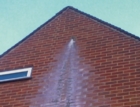Practise safe condensate handling

Paul Greengrass warns of the risks of the improper disposal of condensate from boilers.
Following changes to Building Regulations in 2005, condensing boilers now account for over 98% of the domestic boilers installed in the UK. Changes in the commercial sector have also resulted in gradually increasing volumes of condensing boilers and water heaters.
The efficiency gains are without doubt delivering the UK obligations to the Kyoto protocol. However, every new technology brings challenges that become evident over time.
In most installations condensate can be removed through the normal gravity drain in conjunction with the boiler manufacturer’s instructions. However, if a boiler has to be installed on internal walls or within basements the use of a boiler condensate tank pump or soak away can be the only solution for the installer.
During the early stages of introduction of condensing boilers, the industry has mistaken the pH values as being a key reflection of the acidity levels seem in the condensate. Likening the acidic condensate from boilers to be similar to tomato and orange juice is a little misleading. The pH of condensate from a boiler is typically 2.9 to 4
This misunderstanding has lead to a reasonable number of inappropriate installations which could eventually result in serious damage to the structure of the property.
The reality is that condensate from gas boilers contains nitric acid and that condensate from oil boilers contains a mixture of nitric and sulphuric acids. These condensates will dissolve lime-based mortar.
Under no circumstances should boiler condensate be put straight to ground or down the side of buildings without first being neutralised.
We have seen a reasonable number of installations where the condensate outlet drain is released directly down the side of the house or flat. The result is a heavy white staining as the lime is dissolved from the mortar and flows down the wall. The long term impact will require the brickwork to be re-pointed.
We are also aware of one installation where a condensing boiler has been installed for three years and the condensate drain had been sunk below ground in-line with the foundations. The impact of over 800 litres of condensate per annum washing over the footings has resulted in the need for underpinning in that area.
The impact on the long-term integrity of the footings should be ignored at the property owner’s peril; local authorities and housing associations should be concerned about their assets.
The impact of the local groundwater is also worth further investigation and can be reduced significantly if more installers use condensate pumps to take boiler condensate to normal drainage infrastructure when gravity routes are not available.
Where immediate access to a drain is not available, a condensate tank pump can offer advantages and flexibility. Our pumps, for example, come with 6 m of 9.5 mm small-bore flexible hose which can prove very versatile for connecting to an existing internal sink, washing machine, bath drain or soil and vent stack.

Fitting of a boiler condensate pump can also offer installation and cost savings.
The pumps incorporate a tank which holds a small volume of condensate, with a low-level set point. When the boiler starts, condensate runs into the tank. At a fixed higher set level a float switch is activated, the pump starts and the condensate is pumped out through a non return (check) valve. Typically in domestic applications the pump will operate for about 30 seconds three to four times an hour.
Pumps are available in a number of different specifications depending on the application requirements from domestic to mid range commercial boilers. The amount of vertical lift is an important selection factor
A typical rule of thumb for boilers and water heaters is 0.1 l/h of condensate per boiler kW rating.
The construction of boiler condensate pumps includes stainless-steel shafts and special plastics to cope with acid condensate.
If neutralisation is required, there are also fully integrated units available for boilers of 10 kW to 1MW. These include neutralising pellets within the tank, which can be changed during annual servicing.
To respond to a drain blockage or pump failure, pumps are fitted with a high-level float switch with a volt-free contact which can be either interfaced to lock out the boiler or fitted directly to an audible alarm or building-management system. It is strongly recommended that the high-level float switch is always connected to lock out the boiler or connected to an alarm.
We have been working with industry trade associations and developed a boiler condensate guide and training material to assist with best-practice solutions.
Paul Greengrass is business-development manager with Pump House www.pumphousepumps.com







